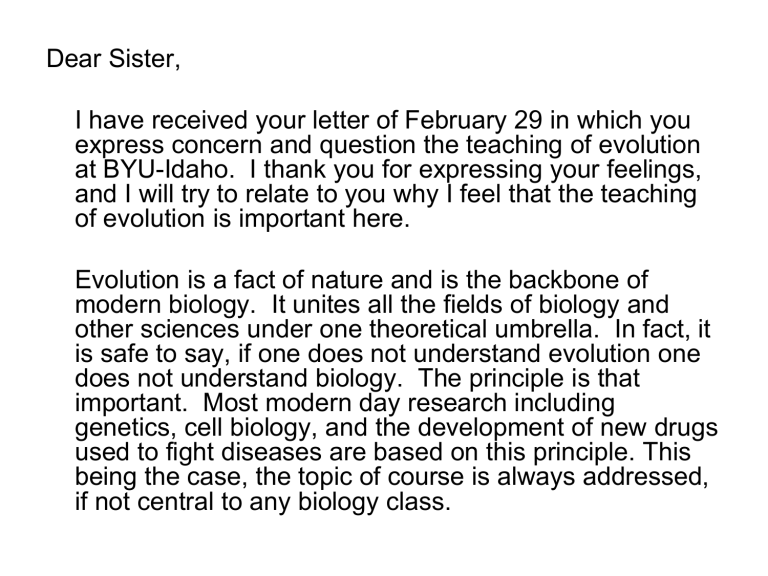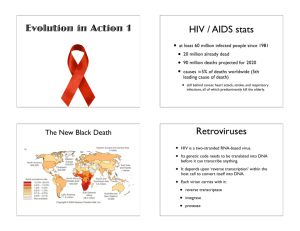A Case for Evolutionary Thinking

Dear Sister,
I have received your letter of February 29 in which you express concern and question the teaching of evolution at BYU-Idaho. I thank you for expressing your feelings, and I will try to relate to you why I feel that the teaching of evolution is important here.
Evolution is a fact of nature and is the backbone of modern biology. It unites all the fields of biology and other sciences under one theoretical umbrella. In fact, it is safe to say, if one does not understand evolution one does not understand biology. The principle is that important. Most modern day research including genetics, cell biology, and the development of new drugs used to fight diseases are based on this principle. This being the case, the topic of course is always addressed, if not central to any biology class.
Death Toll of Major Epidemics.
Disease
Spanish influenza
Deaths
75 million
Smallpox
Bubonic plague
AIDS
60 million
28 million
30 million
50 million by 2020
AIDS is now responsible for about 5% of all deaths worldwide
Sub-Saharan Africa
• Sub–Saharan
• Botswana
• Zimbabwe
• Swaziland
9%
37%
34%
39% (Highest in the world)
• AIDS epidemic has cut the average life expectancy from 62 years to 47 in
Sub-Saharan Africa .
A Case for Evolutionary
Thinking
Understanding HIV
An Evolutionary Perspective can Inform
Researchers about the following questions:
• Why have promising Aids treatments, like the drug azidothymidine (AZT) proven ineffective in the long run?
• Why does HIV kill people?
• Why are some people resistant to becoming infected or to progressing to disease once they are infected?
• Where did HIV come from?
Background of the HIV/AIDS
Epidemic
What is HIV?
Life Cycle of HIV
How Does HIV Cause AIDS
• HIV infects macrophages and helper T cells (CD4 + cells).
• Once these cells are depleted, the immune system collapses.
• Patients are diagnosed with AIDS when their helper T cell count falls below 200 cells per cubic millimeter.
An Evolutionary Perspective Informs
Researchers about the following questions:
• Why have promising Aids treatments, like the drug azidothymidine (AZT) proven ineffective in the long run?
• Why does HIV kill people?
• Why are some people resistant to becoming infected or to progressing to disease once they are infected?
• Where did HIV come from?
Why Does AZT Work in the Short
Run but Fail in the Long Run?
AZT works by stoping reverse transcriptase
• AZT uses an anolog of
Thymidine.
• The Thymidine in AZT has an azide group (-N
3
) in place of the normal hydroxyl group (-OH) on the 3’ carbon.
• Reverse transcriptase can not add more nucleotides to the 3’ end of the growing strand .
The effectiveness of AZT
• In early test, AZT worked, though it caused side effects
• After a few years of use, patients stopped responding to treatment and their CD4 cell counts again began to decline.
• Why?
– Patient’s own cellular physiology could change.
– The population of virions living inside the patient changes so that their reverse transcriptase no longer is effected by AZT.
HIV Populations Evolve
Brendan Larder
Hypothetical difference between AZT sensitive and resistant reverse transcrtiptase
Create an experiment to test the hypothesis
• Use a mutagenic chemical or ionizing radiation to generate strains of HIV with altered nucleotide sequences.
• Grow strains of HIV in the presence of AZT.
• Strains that have the ability to differentiate between AZT thymidine and normal thymidine will produce more often
• Strains unable to replicate in the presence of
AZT would decline in numbers
Analytical Results From Resistant
Patients
• Researchers sequenced the reverse transcriptase gene.
• Strains of HIV that were resistant produced changes in the gene that were not their previously.
• The mutations changed amino acids in the active site of the reverse transcriptase.
• In most cases it was the same amino acid substitutions from patient to patient.
How do mutations occur in HIV’s reverse transcriptase
• Reverse transcriptase is error prone when it copies the RNA into DNA.
• HIV has the highest mutation rate of any organism.
• Changes in the genetic makeup of HIV over time have led to drug resistance.
How Populations of HIV Evolve
1. Transcription errors produce mutations in the reverse transcriptase gene. Some mutations bestow resistance to
AZT.
2. The mutant virions pass their AZT resistant reverse transcriptase genes to their progeny.
How Populations of HIV Evolve
Cont.
• In an AZT rich environment the resistant mutant strains survive and reproduce better than others.
• The population evolves and becomes resistant.
Understanding how resistance evolves, helps in the design of better treatments
• With any single drug just one or a few mutations can render the virus resistant.
• What is needed is a way to increase the number of mutations that must occur before the virion can become resistant.
• The simplest way to increase the number of mutations that must occur at once is to use two or more drugs.
• These Multidrug treatments are known as High
Active Anti-Retroviral Therapy (HAART)
Drugs in use or under development
• Reverse transcriptase inhibitors
– AZT
– 3TC
• Protease inhibitors
– Indinavir
• Fusion inhibitors
• Integrase inhibitors
Resistant Strains
• In the presence of AZT, mutated new strains of
HIV or most efficient at reproduction.
• Are these new resistant strains also more efficient at reproduction when host cells do not contain AZT?
• NO. If AZT therapy is stopped, the proportion of
AZT-resistant virions in the virus population falls until it reaches the level before therapy.
Mutations and the Environment
• Mutations occur randomly - but
• it is the environment that selects the type of genetic variation that will survive and reproduce.
• Or, traits conducive to surviving and reproducing spread throughout the population while traits that are conducive to dying - - - disappear.
Why is HIV Fatal?
• The rapid Evoluton of the HIV population inside a host hastens the collapse of host’s immune system.
• This is short-sighted, because it also hasten the extinction of the HIV population
The immune System’s Reaction.
• The body produces an immune response with antibodies and killer T-cells.
• These bind to epitopes on the surface of the virus or infected cells.
• It takes antibodies and T- cells about a week to become active against a particular epitope.
• An HIV population can produce up to 100 million new virions each day.
HIV’s Ability to Mutate
• Researchers periodically harvested and checked the genetic make-up of gp 120 of virons in a patient.
• First seven years: went from nearly identical to the original, to differing by
8%.
• By year eight the strain differentiation slowed.
Why?
Viral Load.
• The patient’s viral load increased over time.
• Error prone Reverse
Transcriptase still churning out genetically variable types.
T-cell count
• Immune system crashes at the same time the HIV strains stops diverging.
• HIV population free from the selective agent that was forcing it to evolve.
• The strains most capable of rapid replication simply spread, and those less capable became rare.
• Evolution by natural selection does not look to the future. It is just a natural process that happens automatically.
• As a result, the HIV population in any particular host ultimately evolves itself right out of existence.
CCR5 and CXCR4
• Virons that attach to the co-receptor CCR5 are predominant early and then again late in the infection
• CXCR4 become predominant between 5 and 8 years and then rare again by year
11.
• Why?
CCR5 and CXCR4
• At the beginning of an infection CXCR4 T-cells divide less often than T-cells displaying CCR5
• As the infection progresses CXCR4 T-cells begin to divide more rapidly.
• Short sighted evolution?
– Virions that use the CXCR4 T-cells do not get transmitted to a new host
– Also, virions that kill CXCR4 T-cells cause the immune system to collapse and the host to die.
A Correlation between Lethality and Transmission
• There are rare strains of HIV that may not kill their host.
– Sydney Bloodbank Cohort
• Fail to synthesis Nef protein.
• Important in helping HIV virions gain entry into the host.
– HIV-2
• Viral loads are lower
• Why are these less harmful strains rare?
Correlation between Lethality and
Transmission cont-
• Evolutionary point of view.
– All host die at some point.
– To persist beyond the life span of the host the successful strain must colonize new host.
– Thus there are two levels that virions are selected at.
• The ability to survive inside a particular host.
• The ability to transfer to a new host.
– The second level is more important than the first.
Why are some people resistant to infection by HIV?
• Some people who are repeatedly exposed to
HIV do not become infected?
• Studies show that some of these individuals the CCR5 has been mutated that inhibits HIV
– CCR5D32
Where did HIV Come From?
• Nucleotide sequences can be used to determine phylogeny and to construct cladograms.
• The closer two nucleic acid sequences are the closer the two organism are related to each other.
The Origin of HIV
• Two main types of HIV,
HIV-2 and HIV-1, were transmitted from different sources.
• HIV-2 originated in sooty mangabeys.
• HIV-1 was originally transmitted to humans from chimpanzees



